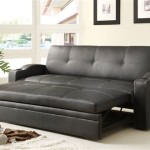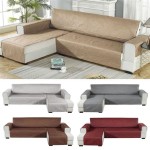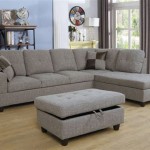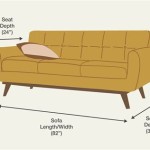Choosing the Right Size Rug Under Your Couch
Selecting the appropriate size rug to place under a couch significantly impacts the overall aesthetic and functionality of a living space. A rug that is too small can make a room feel disjointed and unfinished, while a rug that is too large can overwhelm the space and detract from other design elements. Therefore, understanding the principles of rug placement and size selection is crucial for creating a harmonious and inviting atmosphere.
The optimal rug size is determined by several factors, including the dimensions of the room, the size of the couch and other furniture, the desired style, and the existing flooring. A well-chosen rug can anchor the seating area, define the space, add warmth and texture, and even make a room appear larger. Conversely, a poorly chosen rug can disrupt the flow of the room and detract from the intended design.
Key Point 1: Common Rug Placement Styles
There are three primary rug placement styles commonly employed in living rooms: the “all-on” style, the “front legs on” style, and the “floating” style. Each style offers a distinct visual effect and is suitable for different room sizes and furniture arrangements. Choosing the appropriate placement style is a fundamental step in determining the correct rug size.
All-On Style: This style involves placing all legs of the couch and any accompanying chairs or tables entirely on the rug. This approach is best suited for larger living rooms, where the rug can serve as a prominent focal point and visually connect the entire seating area. To achieve this look effectively, the rug must be large enough to extend at least 6-12 inches beyond the edges of the furniture. This creates a cohesive and unified feel, effectively defining the seating zone within the larger room.
When selecting a rug for the all-on style, consider the overall dimensions of the seating area. Measure the length and width of the space occupied by the couch and any chairs, then add the desired overhang (6-12 inches on each side) to determine the minimum rug size. For instance, if the couch is 8 feet long and the chairs occupy a 6-foot width, and you desire a 1-foot overhang on all sides, the rug should be at least 10 feet long and 8 feet wide.
Front Legs On Style: This is a versatile option suitable for a wider range of room sizes. In this style, only the front legs of the couch and chairs are placed on the rug, while the back legs remain on the bare floor. This approach creates a more grounded and spacious feel, as it allows some of the flooring to remain visible. This style is also more economical, as it requires a smaller rug than the "all-on" style.
To implement the front legs on style, the rug should extend at least halfway under the couch and chairs. Measure the depth of the couch and divide it in half. The rug should be at least that deep. The width of the rug should extend beyond the width of the couch and chairs to frame the seating area. A good rule of thumb is to allow for an extra 12-18 inches on either side of the furniture.
Floating Style: This style involves placing a smaller rug in front of the couch, without any furniture legs resting on it. This is a more casual and contemporary approach, often used in smaller living rooms or when the goal is to add a pop of color or texture without fully anchoring the seating area. The floating style allows the existing flooring to remain a more prominent design element.
When using the floating style, the rug should be large enough to visually connect with the couch and other furniture. It should extend at least a few inches beyond the width of the coffee table and be placed close enough to the couch to create a visual link. This style is particularly effective when paired with a coffee table that complements the rug's color or pattern.
Key Point 2: Standard Rug Sizes and Couch Compatibility
Understanding standard rug sizes is important when selecting a rug for under a couch. These standard sizes are readily available and are designed to accommodate various couch dimensions and room layouts. Common rug sizes include 5x8 feet, 6x9 feet, 8x10 feet, 9x12 feet, and 10x14 feet. The appropriate size depends on the size of the couch and the desired placement style.
5x8 Feet Rug: This size is typically best suited for apartments or smaller living rooms using the floating style. It is suitable for placing in front of a small sofa or loveseat, without any furniture legs resting on it. A 5x8 rug can also be used to define a small seating area within a larger room, such as a reading nook or a conversation corner.
6x9 Feet Rug: This is a versatile size that can be used with the front legs on style for a standard-sized sofa or loveseat. It's also a good choice for the floating style in a slightly larger living room. A 6x9 rug can also accommodate a small coffee table and add some visual interest to the space.
8x10 Feet Rug: This is a popular choice for medium-sized living rooms. It is well-suited for placing under a standard-sized sofa with the front legs on style, or for placing under a smaller sectional sofa with the all-on style. An 8x10 rug provides ample coverage and helps to define the seating area effectively.
9x12 Feet Rug: This size is ideal for larger living rooms. It can comfortably accommodate a standard-sized sofa and a few accent chairs with the all-on style. It can also be used to create a more spacious feel with the front legs on style. A 9x12 rug provides a luxurious and grounded feel to the room.
10x14 Feet Rug: This is the largest standard size and is best suited for very large living rooms or open-concept spaces. It can easily accommodate a large sectional sofa and multiple chairs with the all-on style. A 10x14 rug creates a grand and unified feel, making the seating area the clear focal point of the room.
When choosing a rug size, it is always advisable to measure the space and furniture before making a purchase. Use painter's tape to mark out the dimensions of the rug on the floor to visualize how it will fit into the room. This will help to avoid costly mistakes and ensure that the rug is the right size for the space.
Key Point 3: Considering Room Size and Furniture Arrangement
The overall size of the living room and the arrangement of furniture are crucial factors to consider when selecting a rug size. A rug that is proportional to the room and complements the furniture arrangement will create a more balanced and aesthetically pleasing space. Conversely, a rug that is too small or too large can disrupt the flow of the room and detract from the overall design.
Small Living Rooms: In smaller living rooms, it is generally best to opt for a smaller rug size, such as a 5x8 or 6x9. The floating style or the front legs on style are usually the most effective choices for small spaces, as they allow some of the flooring to remain visible and prevent the room from feeling cramped. Overly large rugs can make a small room feel even smaller.
Medium-Sized Living Rooms: In medium-sized living rooms, a rug size of 8x10 or 9x12 is typically a good choice. Both the front legs on style and the all-on style can work well in these rooms, depending on the furniture arrangement and the desired aesthetic. Consider the placement of other furniture, such as coffee tables and side tables, when determining the appropriate rug size.
Large Living Rooms: In large living rooms, a larger rug size, such as a 9x12 or 10x14, is generally necessary to anchor the seating area and create a sense of cohesion. The all-on style is often the most effective choice for large rooms, as it visually connects the entire seating area and creates a focal point. However, the front legs on style can also work well, especially if the goal is to maintain a more open and airy feel.
Open-Concept Spaces: In open-concept spaces, rug placement is particularly important for defining different zones within the larger area. A large rug can be used to delineate the living room area from the dining area or kitchen. The rug should be large enough to accommodate the furniture in the seating area and create a visual boundary between the different zones. It's important to consider the overall flow of the space and ensure that the rug placement complements the existing architecture and design elements.
Beyond these considerations, other factors impact rug choice, such as the rug’s material, pattern, and color. The material will determine the rug's durability, texture, and care requirements. For high-traffic areas, durable materials like wool or synthetic fibers are recommended. The pattern and color should complement the existing décor and create the desired mood in the room. Lighter colors can make a room feel brighter and more spacious, while darker colors can add warmth and depth. Patterned rugs can add visual interest and personality, while solid-colored rugs can create a more calming and minimalist feel.
Ultimately, the ideal rug size is a balance of functionality, aesthetics, and personal preference. By carefully considering these key points, it is possible to select a rug that enhances the beauty and comfort of the living space.

Choosing The Best Rug Size High Country Furniture And Design

How To Get The Best Living Room Rugs

Rug Placement With Sectional How To Get It Right

What Size Rug To Use In A Living Room Green With Decor

Rug Size Guide To Help You Choose The Right Parachute Home

What Size Area Rug Under Sectional Sofa Placement Guide Homely Rugs

A Guide To How Big Should Living Room Rug Be 4 Expert Sizing Ti

How To Choose Correct Size Rug For Sectional Couches Rugs Direct

How To Choose The Right Size Rug A Living Room Guide

What Size Rug Is Best For A Living Room Sectional








